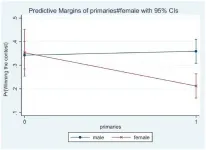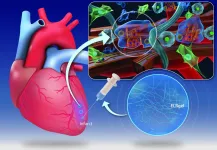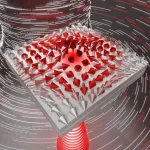(Press-News.org) Assessing a drug compound by its activity, not simply its structure, is a new approach that could speed the search for COVID-19 therapies and reveal more potential therapies for other diseases.
This action-based focus -- called biological activity-based modeling (BABM) -- forms the core of a new approach developed by National Center for Advancing Translational Sciences (NCATS) researchers and others. NCATS is part of the National Institutes of Health (NIH). Researchers used BABM to look for potential anti-SARS-CoV-2 agents whose actions, not their structures, are similar to those of compounds already shown to be effective.
NCATS scientists Ruili Huang, Ph.D., and Wei Zheng, Ph.D., led the research team that created the approach. Their findings were posted online Feb. 23 by the journal Nature Biotechnology.
"With this new method, you can find completely new chemical structures based on activity profiles and then develop completely new drugs," Huang explained. Thus, using information about a compound's biological activity may expand the pool of promising treatments for a wide range of diseases and conditions.
When researchers seek new compounds or look for existing drugs to repurpose against new diseases, they are increasingly using screening tools to predict which drugs might be good candidates. Virtual screening, or VS, allows scientists to use advanced computer analyses to find potentially effective candidates from among millions of compounds in collections.
Traditional VS techniques look for compounds with structures similar to those known to be effective against a particular target on a pathogen or cell, for example. Those structural similarities are then assumed to deliver similar biological activities.
With BABM, however, researchers don't need to know a compound's chemical structure, according to Huang. Instead, they use a profile of a compound's activity patterns -- how it behaves at multiple concentrations against a panel of targets or tests -- to predict its potential effectiveness against a new target or in a new drug assay.
The now-widespread use of quantitative high-throughput screening (qHTS) allows BABM more accuracy in its predictions. qHTS assesses a compound's effectiveness at multiple concentrations in thousands of tests over time. That practice provides far more detail about how a compound behaves than does traditional high-throughput screening, which tests only a single concentration of the compound. The information generated by qHTS creates a stronger biological activity profile -- also known as a signature -- for each one of millions of compounds.
To test the BABM approach, the researchers tapped the vast pool of data generated by hundreds of qHTS analyses run on NCATS' in-house collection of more than 500,000 compounds and drugs. First, they verified BABM's ability to use activity profiles to identify compounds already shown to be effective against the Zika and Ebola viruses. BABM also identified new compounds that showed promise against those viruses.
The scientists then turned to SARS-CoV-2, the virus that causes COVID-19. They applied BABM, a structure-based model and a combined approach to analyze the NCATS library's compounds to find potential anti-SARS-CoV-2 agents. BABM predicted that the activity profiles of 311 compounds might indicate promise against the coronavirus.
The researchers then had an outside laboratory test those 311 compounds against the live SARS-CoV-2 virus. The result: Nearly one-third of the BABM-backed compounds (99) showed antivirus activity in the test. The BABM-driven prediction hit rate topped that of the structure-based model -- and combining the activity-based and structure-based models yielded even better predictive results.
A key advantage to BABM is speed. "This method is very fast -- you essentially just run a computer algorithm, and you can identify many new drug leads, even with new chemical structures," Huang noted. In fact, screening the entire NCATS library of half a million compounds for anti-SARS-CoV-2 candidates took only a few minutes.
BABM also is a transferable tool -- it's not limited to use in the NCATS compound libraries. "Anyone can use this method by applying any biological activity profile data, including publicly available NCATS data," Huang emphasized.
The NCATS researchers predict their activity-based model's impact could extend far beyond the search for COVID-19 treatments and small-molecule drug discovery. Given any substance with an available activity profile, scientists can predict its activity against a new target, for a new indication, or against a new disease.
"In addition to small molecules, this approach can be applied to biologics, antibodies, and other therapies," Huang said. "BABM is for all drug discovery projects."
INFORMATION:
About the National Center for Advancing Translational Sciences (NCATS): NCATS conducts and supports research on the science and operation of translation -- the process by which interventions to improve health are developed and implemented -- to allow more treatments to get to more patients more quickly. For more information about how NCATS helps shorten the journey from scientific observation to clinical intervention, visit ncats.nih.gov.
About the National Institutes of Health (NIH): NIH, the nation's medical research agency, includes 27 Institutes and Centers and is a component of the U.S. Department of Health and Human Services. NIH is the primary federal agency conducting and supporting basic, clinical, and translational medical research, and is investigating the causes, treatments, and cures for both common and rare diseases. For more information about NIH and its programs, visit http://www.nih.gov.
The hidden social, environmental and health costs of the world's energy and transport sectors is equal to more than a quarter of the globe's entire economic output, new research from the University of Sussex Business School and Hanyang University reveals.
According to analysis carried out by Professor Benjamin K. Sovacool and Professor Jinsoo Kim, the combined externalities for the energy and transport sectors worldwide is an estimated average of $24.662 trillion - the equivalent to 28.7% of global Gross Domestic Product.
The study found that the true cost of coal should be more than twice as high as current prices when factoring in the currently unaccounted ...
A study by two researchers at the UPF Department of Political and Social Sciences (DCPIS) has examined the effect of selecting party leaders by direct vote by the entire membership (a process known in southern Europe as "primaries" and in English-speaking countries as "one-member-one -vote", OMOV) on the likelihood of a woman winning a leadership competition against male rivals.
Javier Astudillo and Andreu Paneque, a tenured lecturer and PhD with the DCPIS, respectively, and members of the Institutions and Political Actors Research Group, are the authors of the article published recently in the journal ...
TROY, N.Y. -- The era of widespread remote learning brought about by the COVID-19 pandemic requires online testing methods that effectively prevent cheating, especially in the form of collusion among students. With concerns about cheating on the rise across the country, a solution that also maintains student privacy is particularly valuable.
In research published today in npj Science of Learning, engineers from Rensselaer Polytechnic Institute demonstrate how a testing strategy they call "distanced online testing" can effectively reduce students' ability to receive help from one another in order to score higher on a test taken at individual homes during social distancing.
"Often in remote online exams, students ...
A group of researchers including Tiago Falótico, a Brazilian primatologist at the University of São Paulo's School of Arts, Sciences and Humanities (EACH-USP), archeologists at Spain's Catalan Institute of Human Paleoecology and Social Evolution (IPHES) and University College London in the UK, and an anthropologist at the Max Planck Institute for Evolutionary Anthropology in Germany, have published an article in the Journal of Archeological Science: Reports describing an analysis of stone tools used by bearded capuchin monkeys (Sapajus libidinosus) that inhabit ...
Researchers at CÚRAM, the SFI Research Centre for Medical Devices based at National University of Ireland Galway, and BIOFORGE Lab, at the University of Valladolid in Spain, have developed an injectable hydrogel that could help repair and prevent further damage to the heart muscle after a heart attack.
The results of their research have just been published in the prestigious journal Science Translational Medicine.
Myocardial infarction or heart disease is a leading cause of death due to the irreversible damage caused to the heart muscle (cardiac tissue) during a heart attack. The regeneration of cardiac tissue is minimal so that the damage caused cannot be repaired by itself. ...
Because walleyes are a cool-water fish species with a limited temperature tolerance, biologists expected them to act like the proverbial "canary in a coal mine" that would begin to suffer and signal when lakes influenced by climate change start to warm. But in a new study, a team of researchers discovered that it is not that simple.
"After analyzing walleye early-life growth rates in many lakes in the upper Midwest over the last three decades, we determined that water clarity affects how growth rates of walleyes change as lakes start to warm," said Tyler Wagner, Penn State adjunct professor of fisheries ecology. ...
The Earth's surface is subject to continual changes that dynamically shape natural landscapes. Global phenomena like climate change play a role, as do short-term, local events of natural or human origin. The 3D Geospatial Data Processing (3DGeo) research group of Heidelberg University has developed a new analysis method to help improve our understanding of processes shaping the Earth's surface like those observed in coastal or high-mountain landscapes. Unlike conventional methods that usually compare two snapshots of the topography, the Heidelberg approach can determine - fully automatically and over long periods - when and where surface alterations occur and which type of associated changes they represent.
The method, known ...
A team of researchers from New York University and the New York Genome Center has developed a new computational tool to help understand the function and regulation of human genes. The results, published today in the journal Nature Genetics, demonstrate how to interpret experiments that combine the use of CRISPR to perturb genes along with multimodal single-cell sequencing technologies.
The article describes how the new approach, called mixscape, helped to identify a new molecular mechanism for the regulation of immune checkpoint proteins that govern the immune system's ability to identify and destroy cancer cells.
"Our approach will help scientists to connect ...
The scientists have demonstrated how to structure light such that its polarization behaves like a collective of spins in a ferromagnet forming half-skyrmion (also known as merons). To achieve this the light was trapped in a thin liquid crystal layer between two nearly perfect mirrors. Skyrmions in general are found, e.g., as elementary excitations of magnetization in a two-dimensional ferromagnet but do not naturally appear in electromagnetic (light) fields.
One of the key concepts in physics, and science overall is the notion of a "field" which can describe the spatial distribution ...
A joint research team co-led by City University of Hong Kong (CityU) has developed a new soft tactile sensor with skin-comparable characteristics. A robotic gripper with the sensor mounted at the fingertip could accomplish challenging tasks such as stably grasping fragile objects and threading a needle. Their research provided new insight into tactile sensor design and could contribute to various applications in the robotics field, such as smart prosthetics and human-robot interaction.
Dr Shen Yajing, Associate Professor at CityU's Department of Biomedical Engineering ...






